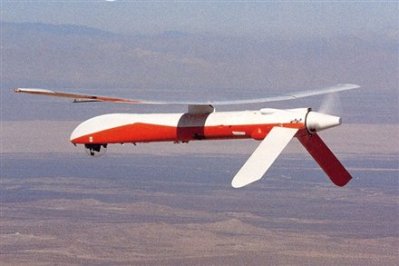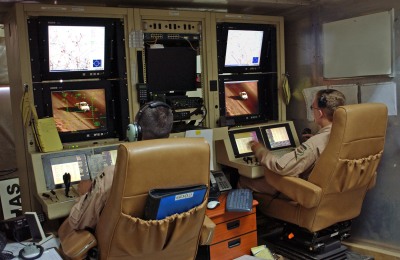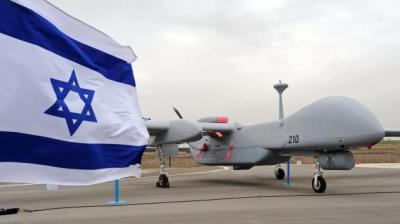Rise of the Reapers: A Brief History of Drones

Part One – the early years
Although some trace the ancestry of today’s drones back to the V-1 rockets (‘doodle bugs’) of the Second World War, or even to the use of hot air balloons laden with explosives in the middle of the 19th Century, the real origins of today’s drones lie in the development of the first recoverable and reusable radio-controlled aircraft in the 1930s. The Royal Navy, looking for aircraft to shoot at for gunnery practice, developed out of the De Havilland Tiger Moth a remote-controlled aircraft dubbed ‘the Queen Bee’. Over 400 of these were built and used for target practice by the Royal Navy in the 1930’s and 1940’s.[1] Similarly (and possibly from this aircraft although that is disputed) the US developed a radio-controlled drone for gunnery practice in the late-30s.
After the Second World War, the US wanted to develop a new drone for air-to-air and ground-to-air target practice and the US company Teledyne-Ryan won the contract with its Firebee UAV. Used as a target drone from early sixties, the Firebee evolved slowly through various modifications until it began to be used solely for reconnaissance and intelligence gathering purposes. A model specifically developed for this purpose, named the Lightening Bug, was used in Vietnam and South Asia in the mid to late 1960s[2] At the end of the Vietnam war 33 were given to Israel where they were used to undertake surveillance missions during the 1973 Yom Kippur War.
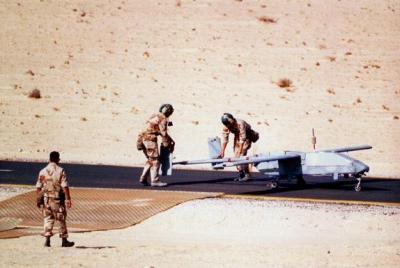
US forces ready a Pioneer drone during Gulf War 1991
The next generation of UAVs would be, as Bill Yenne author of Birds of Prey, a history of US drones, put it, the offspring not of the American initiatives of the 1960s, but of the Israeli initiatives of the 1980s.[3] In the 1970’s and 1980’s, while the US lost interest in drones for intelligence gathering and surveillance purposes (preferring to invest time and money in satellites and hi-resolution imagining) Israel took the lead in drone development, building a number of different surveillance drones. [4] Israeli sold several to the Pentagon, including a drone called the Pioneer which could be launched from a ship or from military base. The US quickly put the Pioneer to use during the First Gulf War where it was used in more than 300 missions.[5]
Enter into our brief history Israeli aerospace ‘maverick’ Abraham Karem said by many to be ‘the man who invented the Predator drone’.[6] In 1974, aircraft engineer Karem, left Israeli military giant Israeli Aircraft Industries to set up his own UAV business. Having no luck selling his ideas to the Israeli military, Karem and his family emigrated to the US where he continued to work on his designs. In the early eighties Karem demonstrated a UAV built in his garage to DARPA who funded flight tests and in 1985 signed a contract with Karem’s new company, Leading Systems to develop a larger endurance UAV called Amber.[7] While Amber flew successfully, due to budget cuts funding for the project was axed. While Karem continued working – including developing a new, simpler UAV based on Amber called the Gnat 750 – financial pressure led to Karem and his company being bought out and eventually being swallowed in 1990 by General Atomics, owned by billionaires Neal and Linden Blue.
Leading System’ Amber UAV – grandfather of the Predator drone
In 1993 the Pentagon wanted to rapidly field a surveillance drone to support UN forces in the former Yugoslavia. The Gnat 750 was selected and by 1994 the first Gnat 750s were deployed to a CIA operating base in Albania for operations throughout the Balkans.[8]
Seeing the success of the Gnat, General Atomics developed a larger UAV, based on Gnat and incorporating satellite communications, named the Predator. This new drone had its first flight in June 1994 and was operationally deployed just a year later in support of the NATO air campaign against Bosnian Serb forces. In 1999 the Predators were again deployed over Kosovo as part of ‘Operation Allied Force’. While the drones were successful in locating targets, a key problem was that communicating the precise location of a target to an armed aircraft was taking time. The solution was to add a laser to the Predator thus enabling the drone operators to simply ‘light up’ a target with its laser which other armed aircraft could then ‘see’ and hit.[9]
The next logical step, according to General John Jumper, the then commander of USAF in Europe (and after 9/11 Air Force Chief of Staff) was to fit the drones themselves with armaments.[10] Told this would take five years and cost $15m Jumper ordered it be done within 3 months at a total cost of $3m.
Part two: Armed drones come into their own
On February 16 2001, US air force officials sitting in a trailer at Indian Springs Airfield in the Nevada desert held their breath as test pilot Curt ‘Hawg’ Hawes punched a button on a control desk.[11] Moments later an inert Hellfire missile flew from a Predator unmanned aerial vehicle flying overhead and hit a disused tank sitting on the ground a few hundred metres away. This was the first ever weapon launch from a Predator unmanned aircraft and the officials present expressed their delight. According to Major Ray Pry, overseeing the tests, the missile “made a big, grey dent in the turret — just beautiful.”[12]
A few weeks later, the first ‘live’ missile tests took place, with this time – and crucially – the signal to launch the missiles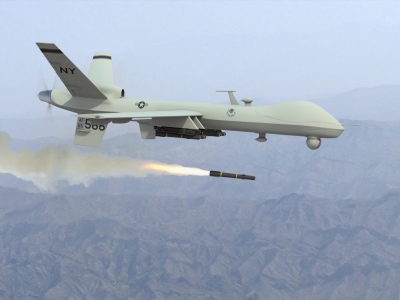 being sent from the trailer to the Predator drone via a satellite circulating the earth hundreds of miles up in space. Again the missiles ‘hit the target’ and the test was deemed a success. [13] Although Air Force officials knew there was more work to be done – including crucially working out how to hit a moving target – they were convinced that their aim of developing a new anti-tank weapon was on track. Little did they know.
being sent from the trailer to the Predator drone via a satellite circulating the earth hundreds of miles up in space. Again the missiles ‘hit the target’ and the test was deemed a success. [13] Although Air Force officials knew there was more work to be done – including crucially working out how to hit a moving target – they were convinced that their aim of developing a new anti-tank weapon was on track. Little did they know.
In the immediate aftermath of the attacks of September 11 2001 infighting between the CIA and the Pentagon over who would be responsible for funding the costs of armed Predator flights over Afghanistan (unarmed flights began in 2000) “became a non-issue” according to then Director of CIA, George Tenet.[14] In the first two months of operations in Afghanistan, some 525 targets were laser designated by Predators and, according to Pete Singer, author of Wired for War, “”the generals who once had no time for such systems couldn’t get enough of them.”[15]
Armed Predator operational flights over Afghanistan began on 7 October 2001[16] with the first Predator drone strike taking place in early November 2001. Details of this first strike, like much that information about drone wars, is swathed in secrecy and confusion. Differing media reports name the target of the first strike as Mohammed Atef, dubbed the military chief of al-Qaida (who was killed along with 6 or 7 other men), Mullah Omar, or Mullah Akhund, the Taliban number three.[17]
General John Jumper, interviewed by David Kohn for CBS 60 Minutes in 2003, acknowledged that there were problems with drone fired Hellfire missiles. As Kohn wrote:
‘The warhead on the Hellfire missile was designed to penetrate the thick armor of a tank before detonating and it wasn’t working well against softer targets. Jumper says it would go through the target and blow up the dirt underneath. Two months after the war in Afghanistan began, the Air Force called Chuck Vessels at the Army’s Redstone Arsenal in Huntsville, Alabama, one of a handful of American engineers who designs and builds warheads. His nickname is “Boom Boom.” Vessels was faced with a tough problem: The Hellfire needed a new warhead, fast, so he didn’t have time to open up the missile and start from scratch. He created an exterior sleeve that would send out shards of the missile when it hit its targets.[18]
Matt Martin, a Predator drone pilot wrote a personal account of operating US drones over Iraq. He too wrote about the changes made to Hellfire missiles for firing from drones:
“We called the third [type] of Hellfire ‘Special K’, a regular K model with an even nastier antipersonnel bonus. When the two charges, wrapped in a sleeve of scored steel, the sleeve shatter along its scored lines and blasted out razor-sharp shrapnel in all directions to slice and dice anyone within a twenty-foot radius (depending on the surface). Even those out to fifty feet might not escape its wrath.” [19]
According to Pete Singer, in their first year of armed operations in Afghanistan, armed Predators “took out” some 115 targets on their own.[20] It should be emphasized that both CIA and USAF operated the fleet of armed Predators over Afghanistan (although ‘fleets’ is perhaps a grand name for the small numbers in operation at this time).
A year later in November 2002 the first lethal operation using a Predator drone took place in Yemen. This time there were no other aircraft involved, just a Predator being controlled by a pilot sitting at Camp Lemmonier in Djibouti. The target this time was Qa’id Salim Sinan (Abu Ali) al-Harithi, allegedly one of those behind the suicide attack on the USS Cole in Port Aden in 2000 which killed 17 Americans. According to media reports Harithi was found when the CIA traced signals from a mobile phone that he had been previously been linked with. The CIA operated Predator followed a car containing Harithi and six other men for over an hour before authority – from US military commander Lt General Michael DeLong – was given to launch the strike. In an interview years later, DeLong recalled speaking by phone with CIA Director George Tenet as he watched the video feed from the Predator:
‘Tenet goes “You going to make the call?” And I said, “I’ll make the call.” He says, “This SUV over here is the one that has Ali in it.” I said, “OK, fine.” You know, “Shoot him.” They lined it up and shot it.’[21]
Many consider this attack to be the first targeted killing by the US using an armed drone – the first of many.
From 2000/2001 unarmed US Predators had been flying surveillance missions over Iraq as part of Operation Southern Watch – the ‘no fly zone’ mission in Iraq after the 1991 Gulf War. At least three Predators were shot down by anti-aircraft fire and another was shot down when a Predator launched a Stinger air-to-air missile at an Iraqi MiG.[22]In 2002 the US began using armed Predators for attack as well as reconnaissance in Iraq, targeting mobile air defence systems in the run up to the invasion on 20 March 2003. Two days after the invasion began, a Predator detected and destroyed a radar-guided anti-aircraft artillery site in southern Iraq, the first Predator strike of Operation Iraqi Freedom.[23]
Perhaps the most controversial use of armed drones began in June 2004 when the first publicly known US drone strike took place in Pakistan. Ironically, although drone strikes in Pakistan are carried out by the CIA (and until January 2012 were neither confirmed or denied [24]) there is much more media attention and information about these ‘covert’ drone strikes – due to the presence of local media – than there are about those that have taken place in Afghanistan and Iraq. Western media reports sometimes suggest that Pakistan is the centre of the drone wars – the reality is that at least three times as many drone strikes have occurred in Afghanistan than in Pakistan. Nevertheless, US drone strikes in Pakistan have been highly controversial as they are seen as a violation of international law.
Israeli Heron drone
While Israel has never officially admitted to having or using armed drones, it is understood that Israel has had such a capability since around 2004. Perhaps the most compelling evidence that Israel uses armed drones comes from a secret US Embassy cables published by Wikileaks detailing drone strikes in Gaza during Operation Cast Lead in 2008-09.[25] A 2009 cable records details of a meeting between US and Israeli officials to discuss IDF activities during Operation Cast Lead. One section of the cable reports IDF Judge-Advocate Brigadier General Avichai Mandelblit detailing an incident in which 15 people were killed and 40 injured:
“the UAV fired two missiles against the [two armed Popular Front] operatives; the first missile failed, but the second hit the operatives. UAV footage of the strike provides evidence that shrapnel entered the mosque through an open door. While the mosque was not intentionally targeted, Mandelblit said, the shrapnel from the attack hit civilians located inside.” [26]
In 2007 with US military commanders increasingly using drones to launch missile attacks, the Predator’s bigger and more lethal brother – the Reaper – was introduced into service first in Afghanistan and then into Iraq. [27]
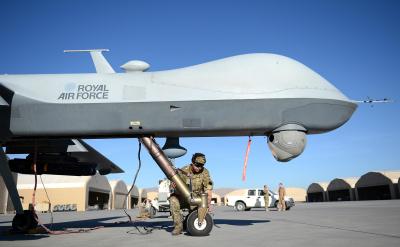 The UK began using their Reaper drones over Afghanistan in October 2007 with the first strike taking place at the end of May 2008. [28] RAF pilots had been operating US armed Predator drones over Iraq since 2004 as part of a USAF/RAF Combined Joint Predator Task Force (CJPTF).[29] According to the Ministry of Defence the first armed attack undertaken by an RAF pilot assigned to this unit took place in late 2004, striking insurgents near the Iraqi town of Najaf.[30] These joint operations had contributed towards the UK deciding to acquire its own armed UAV capability. After a UK Reaper crashed in April 2008, additional Reapers were purchased bringing the number of Reapers owned first up to five and then in July 2014 to ten.[31]
The UK began using their Reaper drones over Afghanistan in October 2007 with the first strike taking place at the end of May 2008. [28] RAF pilots had been operating US armed Predator drones over Iraq since 2004 as part of a USAF/RAF Combined Joint Predator Task Force (CJPTF).[29] According to the Ministry of Defence the first armed attack undertaken by an RAF pilot assigned to this unit took place in late 2004, striking insurgents near the Iraqi town of Najaf.[30] These joint operations had contributed towards the UK deciding to acquire its own armed UAV capability. After a UK Reaper crashed in April 2008, additional Reapers were purchased bringing the number of Reapers owned first up to five and then in July 2014 to ten.[31]
While at the time of writing only the US, the UK and Israel are known to have used armed drones in military operations, this is likely to change soon. Italy and France for example, began operating unarmed Reaper drones in 2011 and 2013 and are likely to begin armed operations in the near future. Many other countries are now using large and small drones for military reconnaissance and intelligence purposes and are likely to acquire or develop armed capability in the near future. While having only a relatively short history, armed drones it seems have a big future.
———–//———–
Further reading: What’s wrong with drones?
Text copyright © Chris Cole, Drone Wars UK. Images maybe subject to copyright. September 2014. Free to re-produce with attribution.
Notes
[1] For more on the early development of drones see Dr Christina Goulter, ‘The Development of UAV’s and UCAV’s: The Early Years’, in Owen Barnes (Ed.), Air Power – UAVs: The Wider Context, RAF Directorate of Doctrine Studies, 2009.
[2] Bill Yenne, Birds of Prey: Predators, Reapers and America’s Newest UAVs in Combat, Specialty Press, 2010, p.14
[5] Michael Hastings, The Rise of the Killer Drones: How America Goes to War in Secret, Rolling Stone, 16.04.2012.
[6] Richard Whittle, The Man Who Invented the Predator, Air & Space magazine, April 2013,
[7] JP Santiago, Genesis of the Predator UAV, Tails Through Time, 26/02/2011
[9] Dr David Jordan and Ben Wilkins, Unmanned Aerial Vehcile Operations since the 1980s, in Air Power: UAVS: The Wider Context, RAF Directorate of Defence Studies, p37
[10] David Kohn, The Predator: The Most Valuable Weapon In The American Arsenal?, CBS News, 07.01.2003.
[11] Matt j. Martin with Charles W. Sasser, Predator: The Remote Control Air War over Iraq and Afgahnistan: A Pilot’s Story, Zenith Press, 2010, p20
[12] Sue Baker, Predator Missile Launch Test Totally Successful, Ai Force News Service, 27.02.01.
[13] In his evidence before the National Commission on Terrorist Attacks Upon the United States, CIA Director George Tenet stated that weapons firing tests from Predator in May and June 2001 gave “mixed results” stating “While missile accuracy was excellent, there were some problems with missile fusing that raised questions about its suitability against some targets.” See ‘Written Statement for the Record of the Director of Central Intelligence Before the National Commission on Terrorist Attacks Upon the United States, March 24, 2004’ p16
[15] P.W. Singer, Wired for War: The Robotics Revolution and Conflict in the 21st Century, Penguin: New York, 2009, p34
[16] Tenet statement. Note non armed surveillance missions had been taking place over Afghanistan since 2000.
[17] Stephen Grey, U.S. Kills Al Qaeda Leaders by Remote Control, The Sunday Times, 18.11.2001. Available athttp://www.foxnews.com/story/2001/11/19/us-kills-al-qaeda-leaders-by-remote-control. See also Chris Woods, Ten years since first deadly drone strike, industry gathers in London, TBIJ, 21/11/2011 and Richard Whittle, How We Missed Mullah Omar, Politico, 16.09.2014. Others suggest first CIA drone strike took place in February 2002 when ‘a tall man’ believed to be Bin Laden was targeted. See: John Sifton, A Brief History of Drones, The Nation, 27/02/2012;
[18] David Kohn, The Predator: The Most Valuable Weapon In The American Arsenal?, CBS News, 07.01.2003.
[19] Matt j. Martin with Charles W. Sasser, Predator: The Remote Control Air War over Iraq and Afgahnistan: A Pilot’s Story, Zenith Press, 2010, p20
[20] P.W. Singer, Wired for War: The Robotics Revolution and Conflict in the 21st Century, Penguin: New York, 2009, p 35
[21] Chris Woods, ‘OK, fine. Shoot him.’ Four words that heralded a decade of secret US drone killings, The Bureau of Investigative Journalism, 03.11.2012. . See also Yenne, p47/48
[22] See Yenne, p48 and Martin, p 21
[23] Dr. Daniel L. Haulman, US Unmanned Aerial Vehicles in Combat, 1991-2003; Air Force Historical Research Agency, 09.06.2003. See also Keith Somerville, US drones take combat role, BBC News, 05.11.2002:
[24] Barack Obama admits US drone strikes on Pakistan, The Telegraph, 31.01.2012
[25] Mary Dobbing, Israel and the Drone Wars: Examining Israel’s production, use and proliferation of UAVs, Drone Wars UK, January 2014
[26] See A/S POSNER DISCUSSES CAST LEAD INVESTIGATIONS WITH IDF, Wilkileaks
[27] Tom Vanden Brook, Drone attacks hit high in Iraq, USA Today, 29.04.2008; David Axe, Killer Drone’s Iraq Debut, Wired, 25.07.2008
[28] Craig Hoyle, UK cheers the Reaper UAV, Flight International, 16.06.08www.flightglobal.com/articles/2008/06/16/224622/uk,-cheers-the-reaper-uav.html
[29] Barnes, Owen (ed.). Air Power: UAVs: the wider context, Royal Air Force Directorate of Defence Studies, 2009, (p51)
[30] Craig Hoyle, RAF strikes in Iraq with Predator, Flight International, 08.02.2005
[31] ‘MoD: More RAF Reapers Take To The Skies’: Ministry of Defence Press Release 03.07.2014


